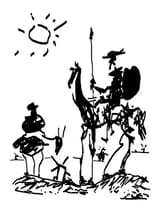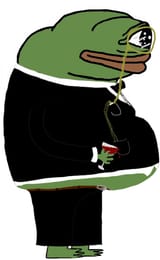Anonymous
7/8/2025, 4:36:25 PM No.24531659
At the heart of Don Quixote lies the tragedy of a man caught between two worlds: the crumbling vestiges of a sacred, hierarchical, symbolically ordered cosmos and the emerging, disenchanted modern age characterized by rationalism, materialism, and desacralization. For Guénon, the essence of modernity is the loss of the transcendent, and in this light, Don Quixote is not simply mad, but symbolic of the anagogical confusion that results when traditional archetypes are misapplied in a profane world.
1. The Hero in a Degenerate Age
Guénon consistently warned against the "reign of quantity"—the domination of the material over the spiritual, the collapse of quality, symbolism, and metaphysical depth. Don Quixote, in his idealism and longing for the chivalric code, may be seen as an anachronistic figure clinging to the echoes of a traditional order. His madness, under this interpretation, is not a personal delusion but a symptom of civilizational dislocation. He seeks to live according to eternal principles in a world that has become blind to them.
Don Quixote’s enemies—windmills mistaken for giants, or innkeepers imagined as castle lords—symbolize the demythologized and desacralized landscape of modernity. They are not real giants because modernity has flattened the symbolic world, and so the hero must project myth back onto it, not out of folly but as a desperate act of spiritual fidelity. This aligns with the Traditionalist view that modern man has lost the ability to perceive the sacred forms and spiritual realities behind phenomena.
2. Satire or Initiatic Parody?
Guénon was highly sensitive to esoteric concealment, especially the idea that metaphysical truths are sometimes hidden under masks of humor or absurdity to protect them from profane understanding. In this light, Don Quixote may be read as an initiatic parody—a spiritual satire that, while appearing to ridicule knightly ideals, actually points to their tragic irrelevance in the modern age, thereby affirming their higher truth through negation.
This echoes Guénon’s defense of traditional symbols and rites as vehicles for metaphysical realization, which are rendered inert or absurd when removed from their proper context. Quixote’s failures thus reveal not the inadequacy of the chivalric ideal, but the world’s inability to support or comprehend that ideal any longer.
1. The Hero in a Degenerate Age
Guénon consistently warned against the "reign of quantity"—the domination of the material over the spiritual, the collapse of quality, symbolism, and metaphysical depth. Don Quixote, in his idealism and longing for the chivalric code, may be seen as an anachronistic figure clinging to the echoes of a traditional order. His madness, under this interpretation, is not a personal delusion but a symptom of civilizational dislocation. He seeks to live according to eternal principles in a world that has become blind to them.
Don Quixote’s enemies—windmills mistaken for giants, or innkeepers imagined as castle lords—symbolize the demythologized and desacralized landscape of modernity. They are not real giants because modernity has flattened the symbolic world, and so the hero must project myth back onto it, not out of folly but as a desperate act of spiritual fidelity. This aligns with the Traditionalist view that modern man has lost the ability to perceive the sacred forms and spiritual realities behind phenomena.
2. Satire or Initiatic Parody?
Guénon was highly sensitive to esoteric concealment, especially the idea that metaphysical truths are sometimes hidden under masks of humor or absurdity to protect them from profane understanding. In this light, Don Quixote may be read as an initiatic parody—a spiritual satire that, while appearing to ridicule knightly ideals, actually points to their tragic irrelevance in the modern age, thereby affirming their higher truth through negation.
This echoes Guénon’s defense of traditional symbols and rites as vehicles for metaphysical realization, which are rendered inert or absurd when removed from their proper context. Quixote’s failures thus reveal not the inadequacy of the chivalric ideal, but the world’s inability to support or comprehend that ideal any longer.
Replies:

